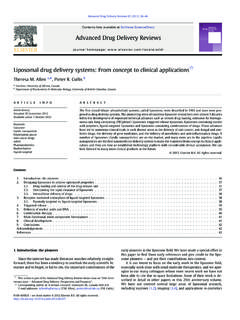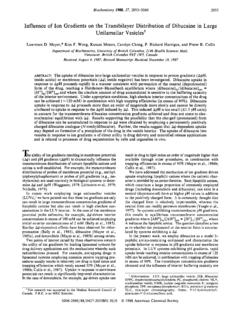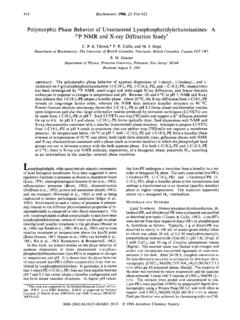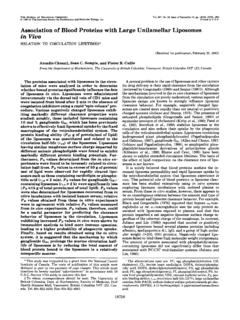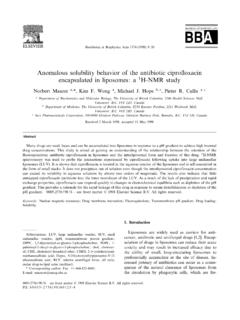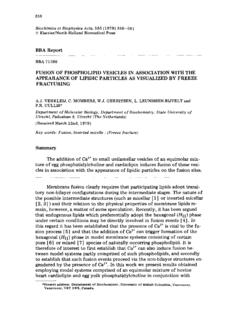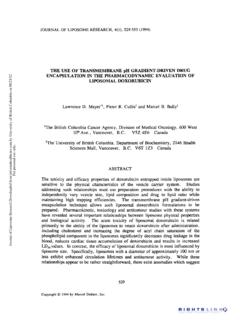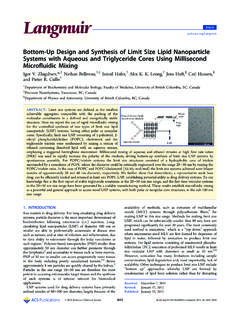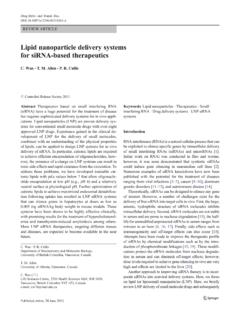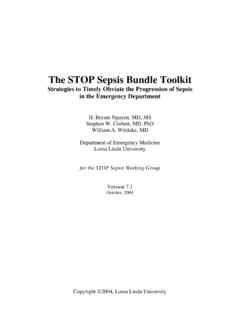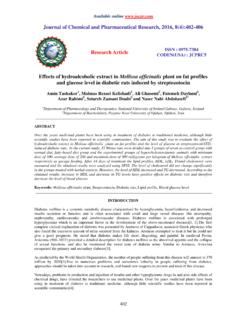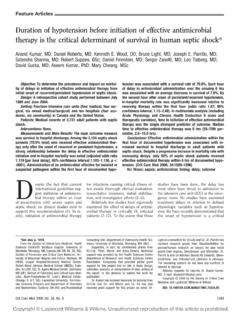Transcription of Accumulation of doxorubicin and other lipophilic amines ...
1 Biochimica et Biophysica Acta, 1149 (1993) 329-338 329 1993 Elsevier Science Publishers All rights reserved 0005-2736/93/$ BBAMEM 76009 Accumulation of doxorubicin and other lipophilic amines into large unilamellar vesicles in response to transmembrane pH gradients Harrigan, Wong, Redelmeier, Wheeler and Cullis Department of Biochemistry, The University of British Columbia, Vancouver (Canada) (Received 25 November 1992) (Revised manuscript received 2 March 1993) Key words: doxorubicin ; Transmembrane pH gradient; pH gradient; Liposome; LUV The uptake of the anticancer agent doxorubicin into large unilamellar vesicles (LUVs) exhibiting a transmembrane pH gradient (inside acidic) has been investigated using both kinetic and equilibrium approaches. It is shown that doxorubicin uptake into the vesicles proceeds via permeation of the neutral form and that uptake of the drug into LUVs with an acidic interior is associated with high activation energies (E a) which are markedly sensitive to lipid composition.
2 doxorubicin uptake into egg-yolk phosphatidylcholine (EPC) LUVs exhibited an activation energy of 28 kcal/mol, whereas for uptake into EPC/cholesterol (55 : 45, mol/mol) LUVs E a = 38 kcal/mol. The equilibrium uptake results obtained are analyzed in terms of a model which includes the buffering capacity of the interior medium and the effects of drug partitioning into the interior monolayer. From the equilibrium uptake behaviour, a doxorubicin partition coefficient of 70 can be estimated for EPC/cholesterol bilayers. For a 100 nm diameter LUV, this indicates that more than 95% of encapsulated doxorubicin is partitioned into the inner monolayer, presumably located at the lipid/water interface. This is consistent with 13C-NMR behaviour as a large proportion of the drug appears membrane associated after Accumulation as reflected by a broadening beyond detection of the 13C-NMR spectrum. The equilibrium Accumulation behaviour of a variety of other lipophilic amines is also examined in terms of the partitioning model.
3 Introduction It is well known that transmembrane pH gradients (ApH) can strongly influence the equilibrium transbi- layer distributions of certain weak acids and bases across biological membranes. Early work in this area includes that of Chappel and Crofts [1] on mito- chondria and Crofts [2] on chloroplasts, demonstrating large transmembrane gradients of weak bases such as ammonia or carboxylic acids such as acetate in re- sponse to ApH. These large concentration gradients arise due to the highly permeable nature of the neutral form of these agents, resulting in transbilayer gradients which reflect the proton gradients. This has led to the Correspondence to: Cullis, Department of Biochemistry, The University of British Columbia, 2146 Health Sciences Mall, Vancou- ver, , Canada V6T 1Z3. Abbreviations: MeNH~-, methylamine; EPC, egg phosphatidyl- choline; CHOL, cholesterol; Hepes, 4-(2-hydroxyethyi)-l-piperazine- ethanesuiphonic acid; LUVs, large unilamellar vesicles; NMR, nu- clear magnetic resonance; TMS, tetramethylsilane.
4 Use of weak acids and bases to assay ApH in cells and organelles [3] and has also stimulated studies in the uptake of other weak bases (such as catecholamines) into liposomes with an acidic interior [4,5]. Recent work from this laboratory has shown that transmembrane pH gradients in large unilamellar vesi- cle (LUV) systems can result in the transbilayer move- ment of a wide range of molecules and atoms of biological interest. These include phospholipids [6,7], metal ions [8], peptides [9] and a variety of drugs [10,11]. The anticancer drug doxorubicin has been a major focus of this work, due to the therapeutic prop- erties of the liposomally encapsulated formulation of the drug which exhibits reduced toxicity (particularly cardiotoxicity) compared to the free form while anti- cancer efficiency is maintained or enhanced [12-14]. The technique of loading doxorubicin into liposomes in response to ApH (inside acidic) provides a dramati- cally improved method of drug loading, as trapping efficiencies approaching 100% can be readily achieved accompanied by drug-to-lipid ratios an order of magni- tude or more larger than can be achieved with conven- 330 tional procedures [14-16].
5 This procedure also markedly enhances drug retention properties. This has led to a liposomal doxorubicin preparation which is currently in advanced clinical trials [17]. The relation between the amount of doxorubicin (and other drugs) accumulated into LUVs in response to ApH, the internal buffering capacity and the resid- ual pH gradient after Accumulation , as well as the kinetics of uptake have not been adequately examined, however. In particular, it has been noted [11] that the transbilayer concentration gradients of doxorubicin achieved in response to ApH considerably exceed those expected on the basis of the residual transbilayer pro- ton gradients, and that uptake is considerably more rapid at elevated temperatures and higher (exterior) pH values. In this work, we develop a kinetic and equilibrium model of the uptake process. It is shown that the uptake of doxorubicin into LUVs with an acidic interior proceeds via Accumulation of the neutral form and that this uptake exhibits high activation ener- gies.
6 Further, the equilibrium behaviour can be ex- plained quantitatively by a model which incorporates the ability of doxorubicin and other drugs to partition into the membrane and also takes into account the influence of internalized drug on the interior buffer capacity. Materials and Methods Vesicle preparation Multilamellar vesicles (MLVs) were prepared by vortexing the (dry) lipid in an appropriate buffer (either 300 mM citrate (pH ) or 150 mM NaCI, 20 mM Hepes (pH ); Hepes-buffered saline, HBS) at 50 mg/ml total lipid. Cholesterol (45 mol% with respect to phospholipid) was incorporated by co-lyophilization from benzene/methanol (70:30, v/v). The lipid dis- persions were frozen and thawed five times (the freez- ing step involved incubating the vial for more than 3 min in liquid nitrogen) to obtain equilibrium trans- membrane buffer distributions [18]. These vesicles were extruded 10 times through two (stacked) Nuclepore polycarbonate filters with 100 nm pore size using an extrusion device (Lipex Biomembranes, Vancouver, ) as described earlier [19].
7 The resulting vesicles are unilamellar, with average diameters of approx. 100 nm. Measurements of interior volumes by determining entrapped citrate buffer led to trapped volumes of l/mol total lipid or 1/mol for EPC/cholesterol (55 : 45, mol/mol) or EPC LUVs, respectively [19]. Uptake of doxorubicin and radiolabeUed probes into L UVs Transmembrane pH gradients were created by preparing LUVs in the presence of 300 mM citrate (pH ), and exchanging the untrapped buffer for 150 mM NaC1, 20 mM Hepes (pH ) employing Sephadex G-50 gel filtration columns. These vesicles were then diluted to a final lipid concentration of approximately 2 mM into a solution containing the indicated concentra- tion of drug dissolved in 150 mM NaCl, 20 mM Hepes (pH ). In situations where a measure of the trans- membrane pH gradient was required, the solution also contained ~Ci/ml [14C]methylamine [20]. For ex- periments in which the external pH was varied, the external medium was first exchanged for 150 mM NaCl, 3 mM citrate (pH ) to reduce the external buffering capacity.
8 Subsequently, these vesicles were diluted into a medium containing 200/~M doxorubicin in 150 mM NaCl, 20 mM Hepes, 20 mM Mes adjusted to the desired pH. Exterior drug and probe was removed by gel filtra- tion chromatography employing 1 ml Sephadex G-50 spin columns previously equilibrated with the appropri- ate buffer. Immediately after loading, the spin-columns were eluted by centrifugation at 2000 g for 3 rain. Quantitation of vesicle associated [14C]methylamine was performed by liquid scintillation counting and phospholipid analysis performed as previously de- scribed [20]. Phospholipid concentrations were deter- mined by analysis of lipid phosphate as described pre- viously [21]. Transmembrane pH gradients measured employing methylamine (MeNH~) are calculated ac- cording to the relation: ApH = Iog([MeNH3]+/tMeNH3] +) where the subscripts i and o indicate the interior and exterior environments, respectively [3,22].
9 Vesicle-associated doxorubicin was determined (after separation of untrapped drug) by measuring the absorbance at 480 nm in a 1% Triton X-100 solution which resulted in vesicle disruption and drug release. At extremely low drug concentrations, internal doxoru- bicin was determined using [~4C] doxorubicin ( mCi/ml). 13 C-NMR studies doxorubicin was made up in solutions of 300 mM citrate (pH ) or 150 mM HBS (pH ). LUVs with or without a pH gradient were added to these solutions to achieve a final lipid concentration of 4 mM, and the final volume adjusted to ml with D20. The proton decoupled laC-NMR spectra were obtained employing a Bruker MSL 200 spectrometer operating at MHz. Free induction decays corresponding to 62000 transients were obtained by using a 10/zs 90 pulse, a 1 s interpulse delay and a 220 ppm sweep width. An exponential multiplication corresponding to 5 Hz was applied to the free induction decay prior to Fourier transformation.
10 The chemical shift is referenced to external TMS. 0 0 0 OH II 14 OCH3 0 OH H O 5' HaC a" V XNH3* OH b DH" /DH +. D D \ Vm DH" < D Vm~ DH" D Outside Inside t J H* Buffer Fig. 1. (a) The structure of doxorubicin . The pK a of the primary amine is (b) Model of the interactions of doxorubicin with phospholipid LUVs exhibiting a transbilayer pH gradient (ApH). The drug assumes two forms, the protonated, membrane imperme- able species (DH + ) and the deprotonated (neutral) membrane per- meable species (D). The interracial volumes Vi m and Vo m into which the drug partitions are exaggerated. 331 for free and membrane associated drug, [D]o m can be expressed as: [D] t t [Dlm= 1 [H+] Vm [H+ ] (2) --+ +--+ K* K~'Ka V o Ka'V o where K*= [DH+]m/[DH+] w is the apparent mem- brane-water partition coefficient for the charged form of the drug, [H+]o is the exterior proton concentration and I" m is the volume of the membrane.]
